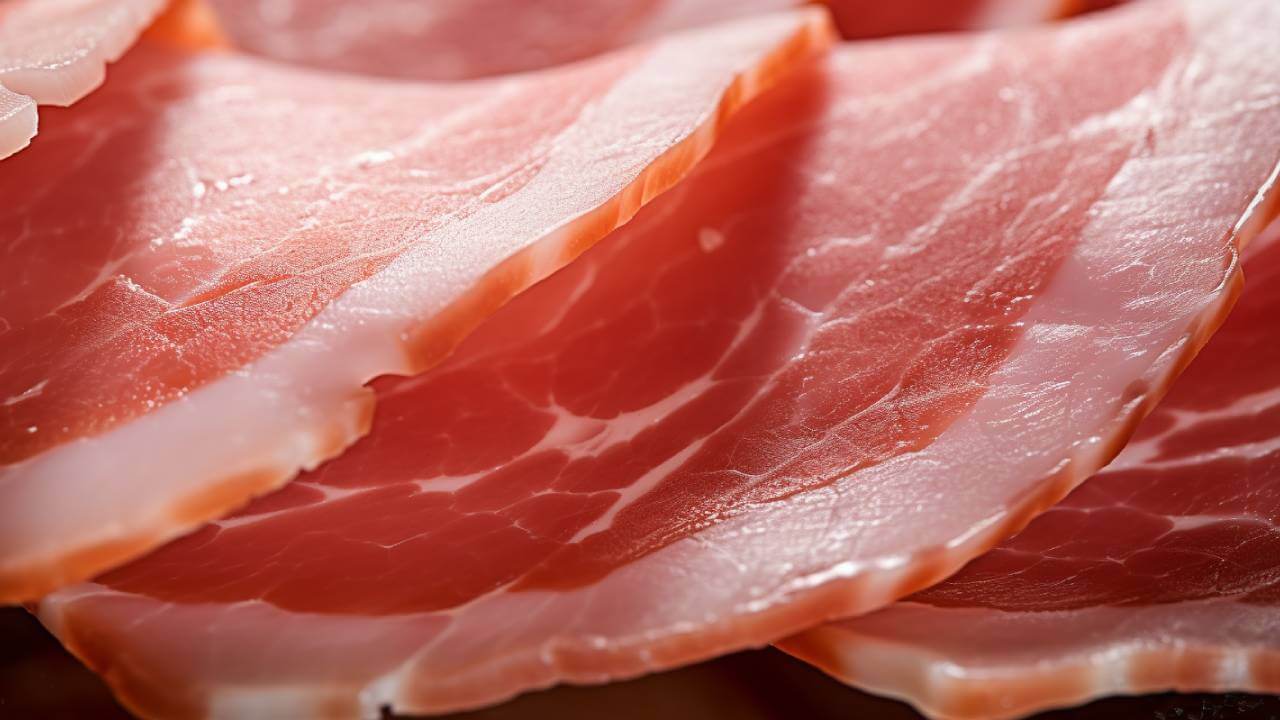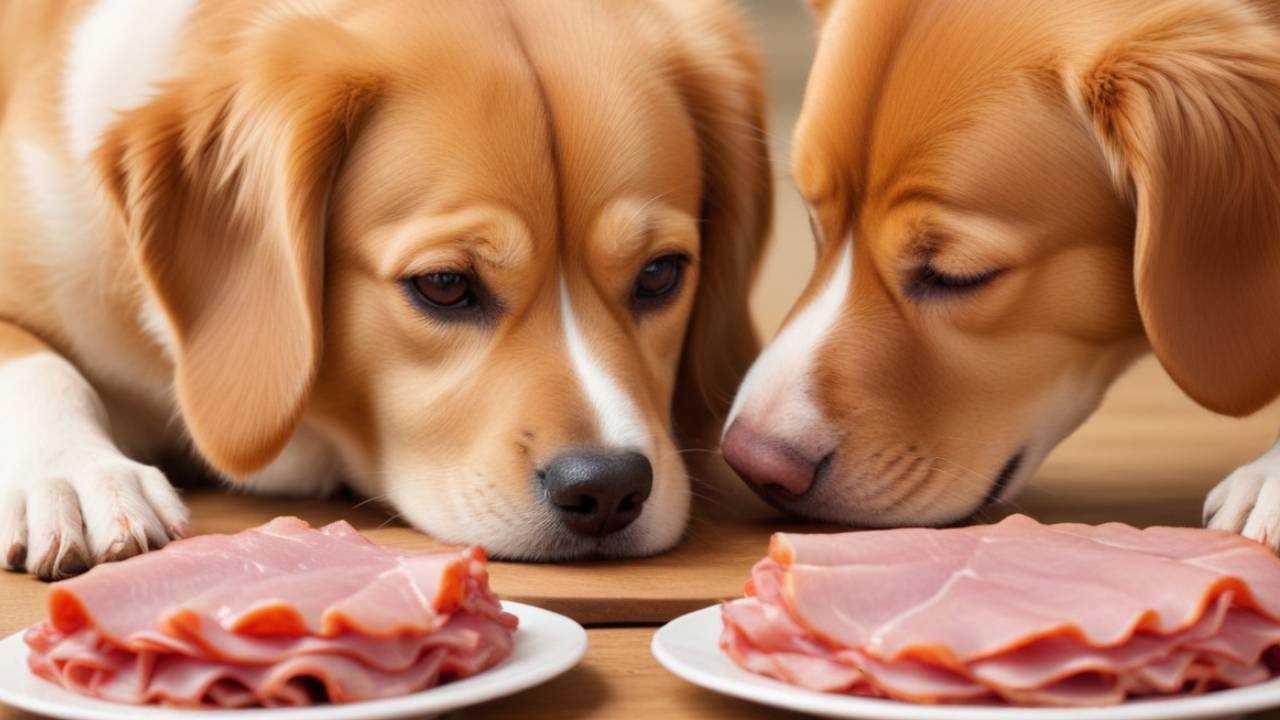Ham is a popular food item humans enjoy, and we naturally want to share tasty treats with our four-legged companions. As pet owners, we often ponder, can dogs have ham? – The short answer is yes, but with significant caution.
In this article, we’ll find out if dogs can have ham, shed light on the safety of ham bones, and explore the potential benefits and risks associated with feeding ham to your canine companion.
Is Ham Good for Dogs?
While ham isn’t toxic to dogs, including it in their regular diet is generally not recommended. Here are several important considerations:
- High sodium content: ham typically contains high sodium, which can harm a dog’s health. Excessive sodium intake can lead to conditions like dehydration and can contribute to more severe issues such as kidney damage or heart disease.
- Fat content: ham can be very fatty, especially if it’s processed or includes visible fat. High-fat foods can lead to pancreatitis in dogs, a painful and potentially life-threatening condition.
- Seasonings and additives: many types of ham are cured with herbs, spices, and other additives that can harm dogs. Ingredients like garlic, onion, and certain preservatives found in ham are toxic to dogs and can lead to gastrointestinal upset or more serious health issues.
- Nutritional balance: dogs require specific ratios of protein, fat, carbohydrates, and essential vitamins and minerals, which ham alone does not provide. Learn more about other human foods dogs can and cannot eat, like can dogs eat walnuts.
Ham can be a tasty treat for your furry friend, but it should be given sparingly, and their safety and health should always be the top priority.
Can Dogs Have Ham Bones?
No, it is not recommended that dogs eat ham bones. While it might seem like a natural treat, ham bones pose several risks. These bones can easily splinter, especially when cooked, and these sharp fragments can cause serious harm to your dog’s mouth, throat, or intestines.
Additionally, ham bones are often too hard for a dog’s teeth, leading to fractures or dental damage.
Moreover, ham bones usually have a high-fat content, which can be difficult for dogs to digest and may lead to pancreatitis, a painful and potentially dangerous inflammation of the pancreas. Given these risks, it’s advisable to avoid giving dogs ham bones and to opt for safer, vet-approved chew toys or treats specifically designed for canine consumption.
Tip: protect your pet from unexpected health issues with the dog insurance plans.
What Should I Do If My Dog Ate Ham?
If your dog has consumed ham, here are the steps you should take:
1. Watch for immediate symptoms
Keep a close eye on your dog for signs of distress, such as choking, vomiting, or difficulty breathing. If your dog experiences severe distress, immediately contact your veterinarian or an emergency animal clinic.
2. Provide fresh water
Ensure your dog has access to clean, fresh water. Drinking water can help dilute the effects of excess sodium or seasoning in the ham.
3. Monitor for digestive Issues
Over the next 24 hours, monitor your dog for any signs of digestive issues, such as diarrhea or abdominal discomfort. If these symptoms persist or worsen, consult your veterinarian.
4. Contact your veterinarian
If your dog has consumed a significant amount of ham or if you are concerned about its health, contact your veterinarian for guidance. Your veterinarian can provide specific advice based on your dog’s size, breed, and overall health.
Curious about other odd behaviors? Find out why dogs eat paper and what it means for your dog’s health. Remember that the severity of the situation can vary depending on the amount and type of ham your dog consumes and their health.

Dogs can have a small serving of plain, unseasoned ham as an occasional treat, so it’s essential to exercise caution. Remember, consulting with your veterinarian is the best way to ensure your dog’s dietary needs are met while keeping them safe. Always prioritize your dog’s safety and well-being when adding new foods to their diet.
Discover 5 reasons why dogs are better than cats for more fun insights about safe dietary choices for your canine companion.

FAQs
How often can I safely give my dog ham as a treat?
Ham is best given sparingly as an occasional treat, no more than once a month. Due to its high fat and sodium content, the ham should be offered in tiny amounts, ensuring it is plain and free from harmful seasonings or additives.
What should I do if my dog steals a large piece of ham?
If your dog consumes a large piece of ham, monitor them closely for signs of sodium ion poisoning, which includes symptoms like vomiting, diarrhea, excessive thirst, or urination. Contact your veterinarian, as they may need to provide treatments that help flush out the excess sodium from your dog’s system.
Are there any specific types of ham that are safer for dogs?
Unseasoned, cooked, plain ham without any additives or spices is the safest option if you give ham to your dog. Avoid processed hams like deli meats or any ham with glazes, as these often contain ingredients and high sodium levels that can harm dogs.
Can puppies have ham, or should it be avoided altogether?
It is generally advisable not to give ham to puppies. Puppies have specific dietary needs for their growth and development and are also more sensitive to rich and fatty foods, which can disrupt their digestive system. Instead, focus on providing a balanced puppy-specific diet that supports their health and growth.
What are some healthy alternatives to ham for dog treats?
Consider cooked and unseasoned lean meats like chicken, turkey, or beef for healthier treat options. Small amounts of cooked vegetables such as carrots or green beans can also be good treats. Always consult your veterinarian before introducing new foods into your dog’s diet.
References:
- Raw diets: This info discusses the potential dangers associated with feeding raw diets to dogs, particularly the risks to human health from handling raw meat.
- Re-evaluating your dog’s diet—This article emphasizes the importance of regularly assessing and adjusting it to meet its nutritional needs and address any emerging health concerns.
- Clinical health markers in dogs fed raw meat-based or commercial extruded kibble diets are compared, providing valuable insights into the impacts of diet on canine health.
- Is Homemade food good or bad for your dog? — This source explores the pros and cons of homemade diets for dogs, helping owners make informed decisions about whether to cook for their pets or rely on commercially prepared foods.






I have to be very careful when giving the dog ham